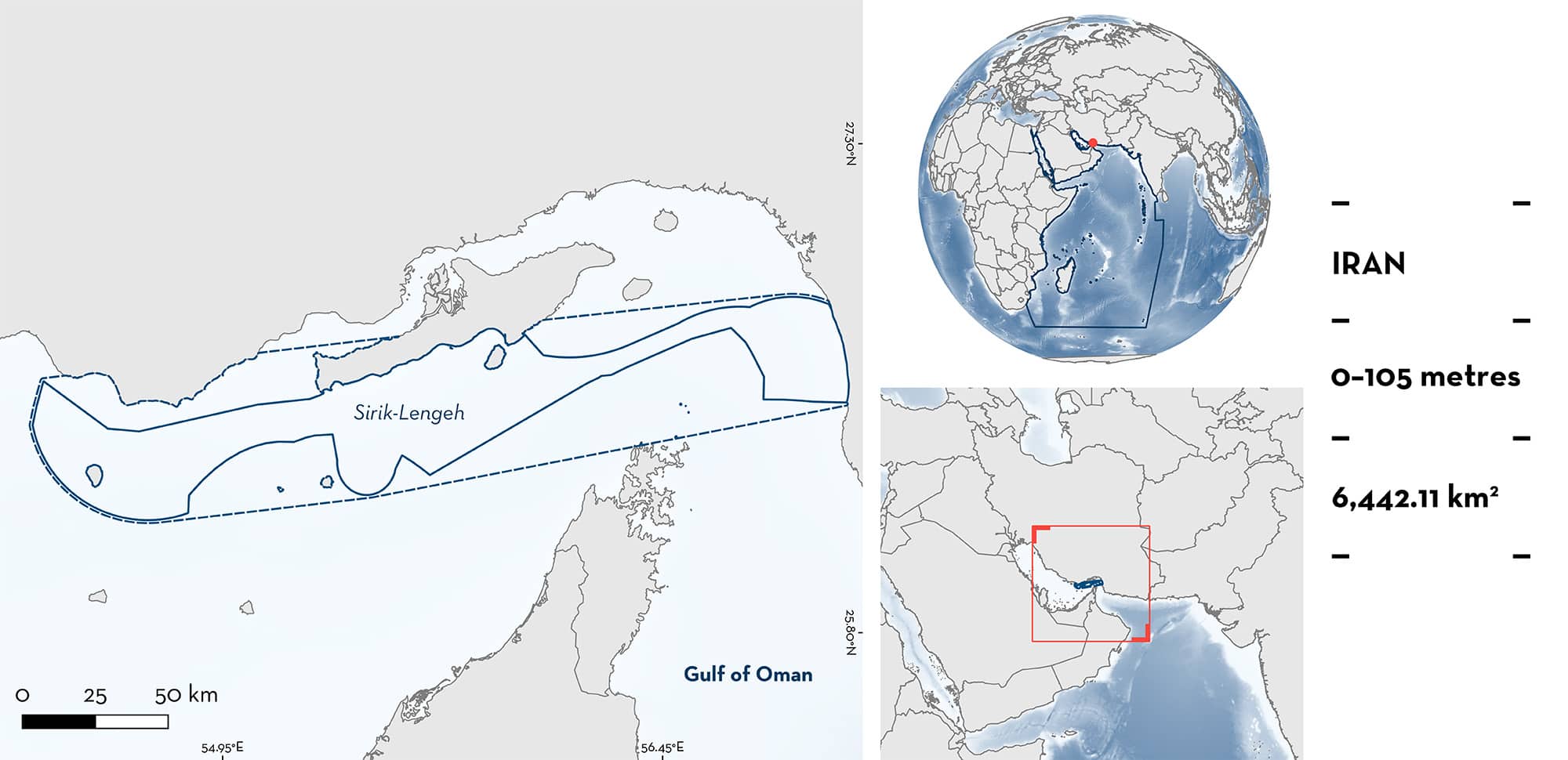ISRA FACTSHEETS
ISRA FACTSHEETS
WESTERN INDIAN OCEAN REGION
Sirik-Lengeh
Summary
Sirik-Lengeh comprises continental shelf waters of the Strait of Hormuz in the Iranian Persian Gulf. The area is characterised by various benthic habitats, including coral reefs (surrounding several islands in the area), and rocky and sandy substrates. The area includes Farur Island Protected Area and overlaps with the Qeshm Island and Adjacent Marine and Coastal Areas Ecologically or Biologically Significant Marine Area. Within the area there are threatened species; range-restricted species; and reproductive areas (Tentacled Butterfly Ray Gymnura tentaculata).
Download factsheet
Sirik-Lengeh
DESCRIPTION OF HABITAT
Sirik-Lengeh comprises continental shelf waters of the Strait of Hormuz in Iranian waters of the Persian Gulf. The area is situated from Bandar-e-Hasineh village in the west to Sirik City in the east. It includes mainland coastal zones at the eastern and western ends of the area boundaries, insular habitats of southern Qeshm Island (the Persian Gulf’s largest island with an area of ~1,480 km2), and surrounding smaller islands (e.g., Hengam, Farur).
The area is relatively shallow and is influenced by the high variations in environmental conditions that are characteristic of the Persian Gulf including high salinity (45 ppt) and variable sea surface temperatures, ranging ~11°C in winter to ~36°C in summer (Sheppard et al. 2010; Bargahi et al. 2020). The area includes various benthic habitats such as coral reefs (surrounding several islands in the area), and rocky and sandy substrates. Hard sandy and rocky substrates are distributed mainly in the western part of the area (i.e., from western Qeshm Island to the western border), the southern coastline of Qeshm Island, and surrounding smaller islands in the area.
There is low water exchange between the Persian Gulf and Gulf of Oman. The salinity in the Persian Gulf is higher than in the Indian Ocean due to high levels of evaporation, with currents supplying lower salinity waters across the Strait of Hormuz (Sheppard et al. 2010; Pous et al. 2015). The less saline and nutrient-rich incoming currents that enter the Persian Gulf via the Strait of Hormuz influence the coral reefs (Shokri et al. 2005).
The area includes Farur Island Protected Area (~28 km2) (DOE 2023) and overlaps with the Qeshm Island and Adjacent Marine and Coastal Areas Ecologically or Biologically Significant Marine Area (CBD 2023).
This Important Shark and Ray Area is benthic and is delineated from inshore and surface waters (0 m) to 105 m based on the bathymetry of the area.
CRITERION A
VULNERABILITY
The one Qualifying Species within the area is considered threatened with extinction according to the IUCN Red List of Threatened SpeciesTM. The Tentacled Butterfly Ray is assessed as Critically Endangered (Jabado et al. 2021).
CRITERION B
RANGE RESTRICTED
The area holds the regular presence of Tentacled Butterfly Ray as a resident range-restricted species.
Data from research and demersal shrimp trawl surveys were used to calculate Catch-Per-Unit-Area (CPUA; number of individuals/km2; Pauly 1980) for Tentacled Butterfly Ray. Mean CPUA for the species was 60 individuals/km2 (range = 5–201). The species had a higher abundance inside the area than outside the area (mean CPUA = 16 individuals/km2; range = 2–36). Beyond its Iranian Persian Gulf range, there are no contemporary records of the species from any other location (Rezaie-Atagholipour et al. 2023). Tentacled Butterfly Ray is restricted to the Arabian Sea Large Marine Ecosystem (LME).
CRITERION C
SUB-CRITERION C1 – REPRODUCTIVE AREAS
Sirik-Lengeh is important for the reproduction of one ray species. Data on reproductive activities are derived from research and demersal shrimp trawl surveys undertaken during 2019–2020 which incidentally captured Tentacled Butterfly Ray (M Rezaie-Atagholipour unpubl. data 2019–2020).
The CPUA of Tentacled Butterfly Ray from the trawl surveys was examined across Iranian waters to identify the area representing core occurrence and evidence of reproductive activities. Based on the size of near-term embryos and free-swimming individuals (Rezaie-Atagholipour et al. 2023), Tentacled Butterfly Rays of < 25 cm DW were assumed to be in early life stages (i.e., neonates and young-of-the-year). Individuals of this size class comprised 34% of all 327 Tentacled Butterfly Rays examined from the area.
Download factsheet
SUBMIT A REQUEST
ISRA SPATIAL LAYER REQUEST
To make a request to download the ISRA Layer in either a GIS compatible Shapefile (.shp) or Google Earth compatible Keyhole Markup Language Zipped file (.kmz) please complete the following form. We will review your request and send the download details to you. We will endeavor to send you the requested files as soon as we can. However, please note that this is not an automated process, and before requests are responded to, they undergo internal review and authorization. As such, requests normally take 5–10 working days to process.
Should you have questions about the data or process, please do not hesitate to contact us.


